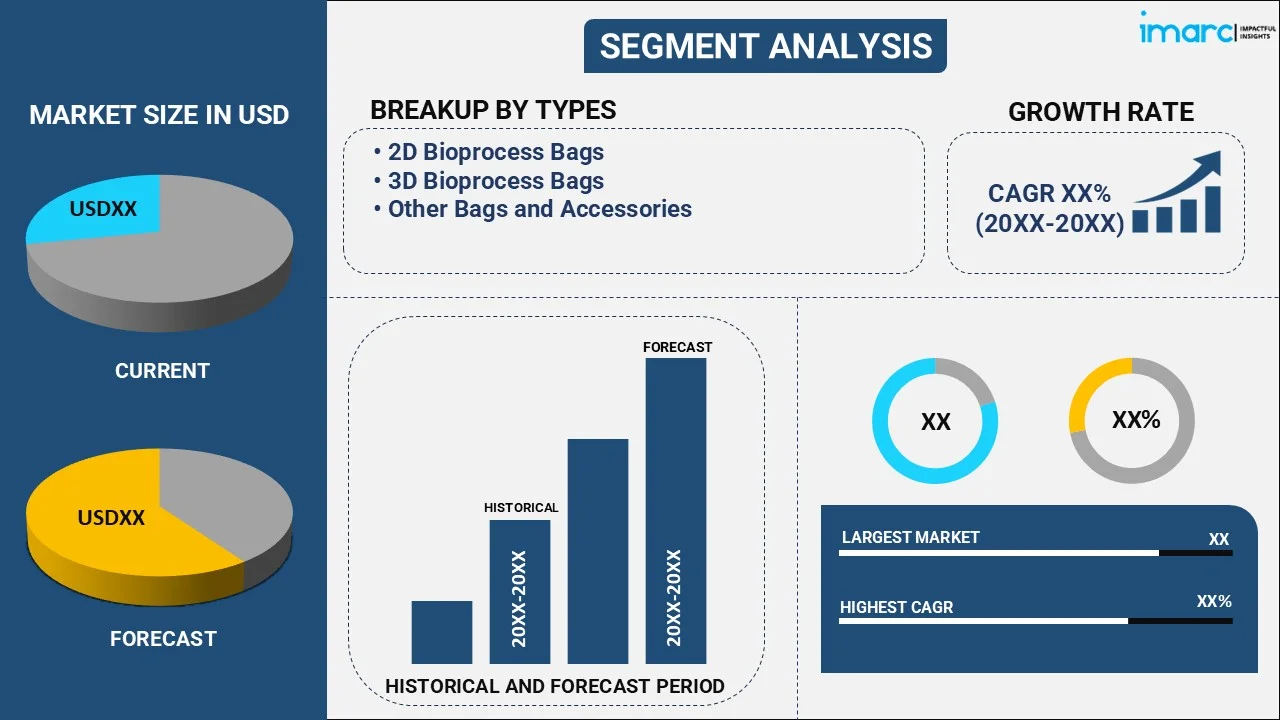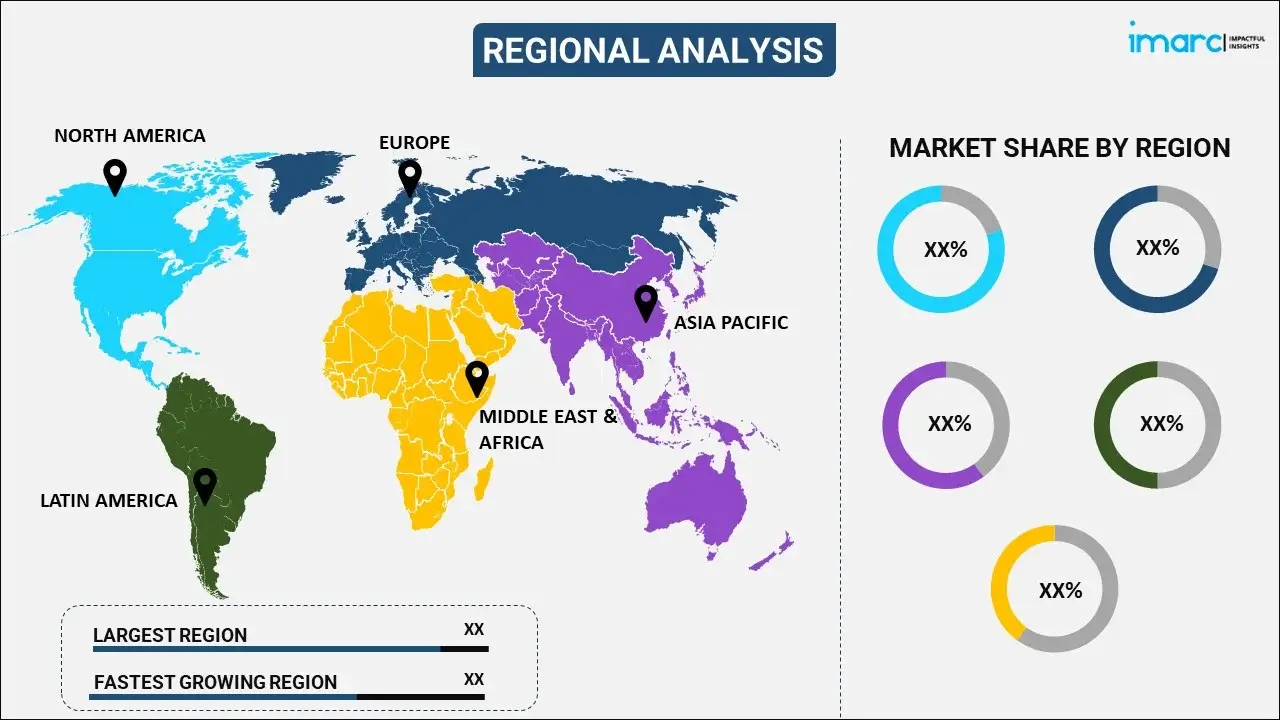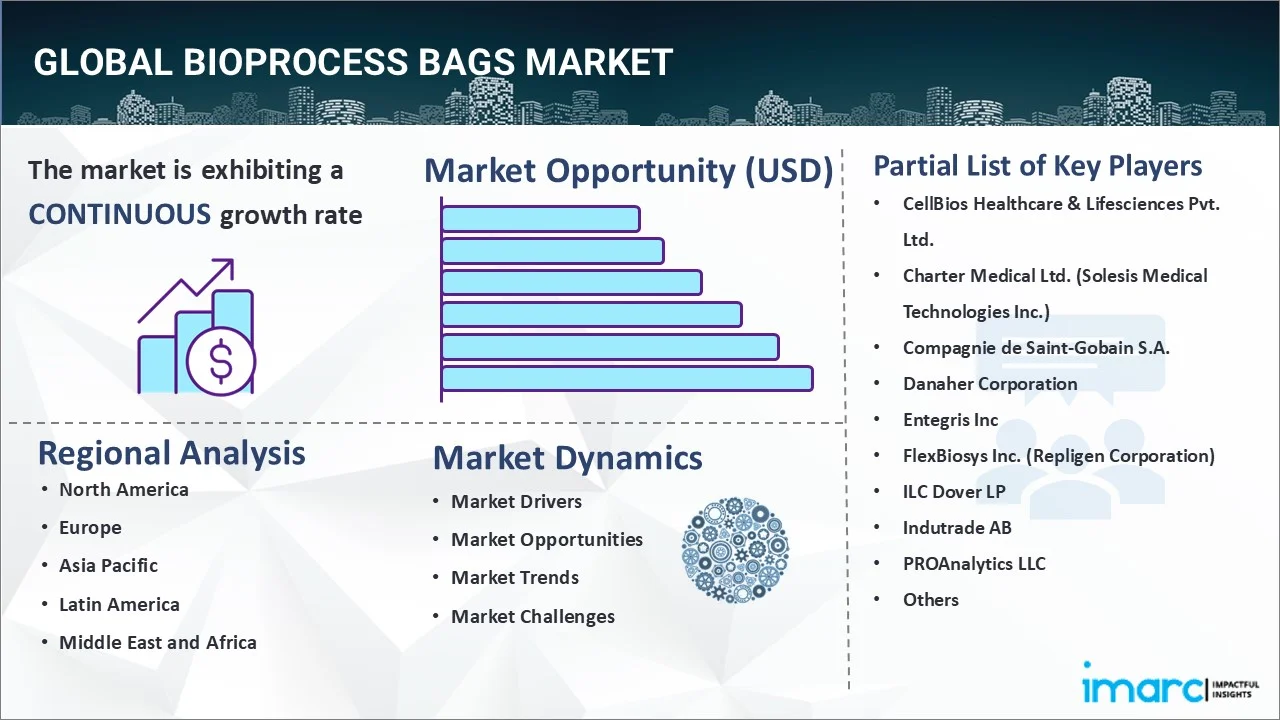
Bioprocess Bags Market Report by Type (2D Bioprocess Bags, 3D Bioprocess Bags, Other Bags and Accessories), Workflow (Upstream Process, Downstream Process, Process Development, and Others), End User (Pharmaceutical and Biopharmaceutical Companies, CMOs and CROs, Academic and Research Institutes, and Others), and Region 2025-2033
Bioprocess Bags Market Size:
The global bioprocess bags market size reached USD 4.0 Billion in 2024. Looking forward, IMARC Group expects the market to reach USD 14.4 Billion by 2033, exhibiting a growth rate (CAGR) of 14.62% during 2025-2033. The market is mainly fueled by increasing infrastructure for biomanufacturing, rising demand for biopharmaceuticals, advancements in single-use technologies, adoption of personalized medicine, rapid proliferation of cell and gene therapies, emerging need for high-throughput systems, and heightening number of biopharma dealing with suppliers.
|
Report Attribute
|
Key Statistics
|
|---|---|
|
Base Year
|
2024
|
|
Forecast Years
|
2025-2033
|
|
Historical Years
|
2019-2024
|
|
Market Size in 2024
|
USD 4.0 Billion |
|
Market Forecast in 2033
|
USD 14.4 Billion |
| Market Growth Rate 2025-2033 | 14.62% |
Bioprocess Bags Market Analysis:
- Major Market Drivers: The global bioprocess bags market is primarily driven by increasing consumption of biopharmaceuticals, progress in single use systems, and rising utilization of personalized drugs. Moreover, the growing use of cell and gene therapies and an increase in biomanufacturing investments are supporting the market growth.
- Key Market Trends: Some of the current trends in the market are the adoption of single-use technologies, growing interest in flexible and scalable bioreactors, and the use of disposable bags primarily in downstream processing. Collaboration between biopharma firms and their suppliers also contributes to innovation and market development.
- Geographical Trends: North America holds the largest bioprocess bags market share in the bioprocess bags market due to the well-developed biopharmaceutical and healthcare sectors and high focus on spending on research and development. Personalized medicine and cell therapies are also the leader of this region in the market, while European and Asia-Pacific regions are signaling advancement.
- Competitive Landscape: Some of the major market players in the bioprocess bags industry include CellBios Healthcare & Lifesciences Pvt. Ltd., Charter Medical Ltd. (Solesis Medical Technologies Inc.), Compagnie de Saint-Gobain S.A., Danaher Corporation, Entegris Inc, FlexBiosys Inc. (Repligen Corporation), ILC Dover LP, Indutrade AB, PROAnalytics LLC, Sartorius AG, Thermo Fisher Scientific Inc, among many others.
- Challenges and Opportunities: Potential challenges include issues related to plastic material waste and the environment, regulatory compliance, and other compliance forms. However, there are opportunities in regions such as sustainability, new biodegradable materials, and the increasing biopharma markets in new economies.
Bioprocess Bags Market Trends:
Growing Demand for Pharmaceuticals
Nowadays, there ahs been an increasing demand for pharmaceuticals rather than conventional medicines. Such products as monoclonal antibodies, vaccines and cell therapies classify themselves under products that need certain controlled environments in their production. This is because they are sterile flexible and cheaper methods of processing and storing bioproducts in these environments. The demand for these bags is particularly high in the developed regions of the world such as North America and Europe as those regions have a well-developed biopharmaceutical industry. For example, applying biotech industries in emerging markets means that the need for bioprocess bags shall further increase across the globe. For instance, as per the National Institutes of Health (NIH), more than 40% of the new drugs approved are biologics, underlining the importance of bioprocess bags in the growth of the biopharmaceutical industry.
Advancements in Single-Use Technologies
Single-use technologies (SUTs) are used in biomanufacturing as they provide key advantages over stainless-steel bioreactors. Some of these technologies include bioprocess bags which reduce the costs of cleaning and sterilizing, help minimize contamination, and enhance manufacturing versatility. Due to increasing biopharma market demand for more flexible and cost-effective production methods, SUT, including bioprocess bags, are being utilized. The use of bioprocess bags has been encouraged by advancements such as multiple-layer film systems and improved barrier features. Demand for vaccines and the associated track record of speedy development in the current world has emphasized scalable and disposable bioprocessing systems. As reported by IMARC Group, the global single-use bioprocessing market size reached US$ 16.1 Billion in 2023 and is expected to reach US$ 64.5 Billion by 2032, exhibiting a growth rate (CAGR) of 16.2% during 2024-2032.
Rising Adoption of Personalized Medicine
Precision medicine that involves the delivery of treatment based on the patient characteristics is currently being embraced by the healthcare sector. This approach sometimes entails the construction of small but multiple numbers or distinct synthesis and purification processes of biologics, hence necessitating efficient bioprocessing methods. For instance, Personalized Medical Coalition identifies 132 personalized medicines, that are, drugs that direct toward one or many biomarker(s) in their labels for direct usage, currently available on the market. The fact that bioprocess bags are flexible and easy to use makes them perfect for the production of personalized medicine. They enable modification of manufacturing processes easily hence minimizing time periods where therapies cannot be manufactured effectively. Bioprocess bags find their application in carrying therapies such as CAR-T cell therapies and gene therapies and, hence, directly proportional to the growth in these markets.
Bioprocess Bags Market Segmentation:
IMARC Group provides an analysis of the key trends in each segment of the market, along with forecasts at the global, regional, and country levels for 2025-2033. Our report has categorized the market based on type, workflow, end-user.
Breakup by Type:

- 2D Bioprocess Bags
- 3D Bioprocess Bags
- Other Bags and Accessories
2D bioprocess bags account for the majority of the market share
The report has provided a detailed breakup and analysis of the market based on the type. This includes 2D bioprocess bags, 3D bioprocess bags, and other bags and accessories. According to the report, 2D bioprocess bags represented the largest segment.
As per the bioprocess bags market report, 2D bioprocess bags are the major product type due to their flexibility and high performance when used for the handling and storage of biopharmaceutical products. Despite some variation in performance depending on the scale of operation, the following advantages can be attributed to these bags for small to medium-scale bioprocessing: ease of use, elimination of contamination risks, and the possibility of saving on relatively expensive stainless-steel systems. They are being used commonly in media preparation, buffer storage, and intermediate product storage to meet the ever-growing requirement for switchable, versatile, and efficient biomanufacturing platforms. The rise in dependency on single-use technologies for custom-specific applications such as personalized medicine and small-scale production has spurred the demand for 2D bioprocess bags.
Breakup by Workflow:
- Upstream Process
- Downstream Process
- Process Development
- Others
Upstream process holds the largest share of the industry
A detailed breakup and analysis of the market based on the workflow have also been provided in the report. This includes upstream process, downstream process, process development, and others. According to the report, upstream process accounted for the largest market share.
The upstream process continues to fuel the bioprocess bags market as it seeks to meet the need for enhanced and scalable solutions for the manufacture of biopharmaceuticals. Some of the upstream process such as cell culture and fermentation need large volumes of media and additives which can be easily handled using bioprocess bags as they are flexible and have low the risk of contamination is high. These bags are used in cell expansion, media preparation, and storage and make for work improved, economical addition. This innovation is indicative of the increased demand for efficiency in the upstream processing and clearly demonstrates the growth of the market due to the new biotechnological production techniques employed.
Breakup by End User:
- Pharmaceutical and Biopharmaceutical Companies
- CMOs and CROs
- Academic and Research Institutes
- Others
Pharmaceutical and biopharmaceutical companies represens the leading market segment
The report has provided a detailed breakup and analysis of the market based on the end user. This includes pharmaceutical and biopharmaceutical companies, CMOs and CROs, academic and research institutes, and others. According to the report, pharmaceutical and biopharmaceutical companies accounted for the largest market share.
The pharmaceutical and the biopharmaceutical industries have high interest in the bioprocess bags market because they require affordable and effective production methods. These companies utilize bioprocess bags in many operations including media preparation, buffer storage, and product transport because of several benefits that the bags afford over other traditional methods as will be seen below with regards to contamination and cleaning. This demand is also further supported by the rapidly growing development of new biologics and vaccines. This increasing rate of biologic drug development results in a constant demand for innovative bioprocessing solutions, thereby propelling the consumption of bioprocess bags.
Breakup by Region:

- North America
- United States
- Canada
- Europe
- Germany
- France
- United Kingdom
- Italy
- Spain
- Others
- Asia Pacific
- China
- Japan
- India
- South Korea
- Australia
- Indonesia
- Others
- Latin America
- Brazil
- Mexico
- Others
- Middle East and Africa
North America leads the market, accounting for the largest bioprocess bags market share
The report has also provided a comprehensive analysis of all the major regional markets, which include North America (the United States and Canada); Europe (Germany, France, the United Kingdom, Italy, Spain, Russia, and others); Asia Pacific (China, Japan, India, South Korea, Australia, Indonesia, and others); Latin America (Brazil, Mexico, and others); and the Middle East and Africa. According to the report, North America was the largest regional market for bioprocess bags.
The bioprocess bags market is mainly led by North America resulting from increased focus on the biopharmaceutical industry, enhanced healthcare, and more R&D investments in research. According to the National Science Foundation, the United States has emerged as the largest performer of research and experimental development (R&D), spending an estimated $806 billion in gross domestic expenditures on R&D in 2021This large amount invested in research and development shows that North America remains at the forefront of driving innovations within the bioprocessing space and sustains the top position in the market. The region’s dominance is due to a well-developed original equipment manufacturer base of large biopharmaceutical companies, which adopts new bioprocessing technologies when moving to commercial scale. Also, there is an array of regulations currently in place in the North American countries that propels the enhancements of biomanufacturing processes and aids in the growth of the market.
Competitive Landscape:
- The market research report has also provided a comprehensive analysis of the competitive landscape in the market. Detailed profiles of all major companies have also been provided. Some of the major market players in the bioprocess bags industry include CellBios Healthcare & Lifesciences Pvt. Ltd., Charter Medical Ltd. (Solesis Medical Technologies Inc.), Compagnie de Saint-Gobain S.A., Danaher Corporation, Entegris Inc, FlexBiosys Inc. (Repligen Corporation), ILC Dover LP, Indutrade AB, PROAnalytics LLC, Sartorius AG, and Thermo Fisher Scientific Inc.
(Please note that this is only a partial list of the key players, and the complete list is provided in the report.)
- Key players in the bioprocess bags market are especially investing in new products or making acquisitions to create more efficient products. They are continuing to invest in research and development (R&D) to improve bioprocess bags, especially in features such as durability, sterilization, and contamination. Another approach is cooperation with biotech companies in the development of specific products in response to the requirements of certain bioprocessing applications. Furthermore, these companies are also increasing production capabilities in international markets with emerging biopharmaceutical sectors inclusive of Asia Pacific. Another trend which is observed is the focus on sustainability, as main industry players invest in materials and recycling programs to mitigate environmental impacts associated with single-use technologies. All these efforts they stated have the cumulative effect of helping them to bolster their market standing and respond to the dynamic needs of the biopharma market.
Bioprocess Bags Market News:
- March 5, 2024: The Sartorius Group, a global supplier of pharmaceutical and laboratory equipment, with a focus on bioprocess solutions, developed Sartorius Flexboy single-use bag that represents a 2D bag variant, obtainable in bag chamber volumes ranging from 5 ml to 50 L. This adaptable series of Flexboy Pre-Designed Solutions (PDS) facilitates the handling of any biopharmaceutical fluid, including sterile filtration, transfer, and storage. The diverse configurations offered are designed for seamless integration into various process steps.
Bioprocess Bags Market Report Scope:
| Report Features | Details |
|---|---|
| Base Year of the Analysis | 2024 |
| Historical Period | 2019-2024 |
| Forecast Period | 2025-2033 |
| Units | Billion USD |
| Scope of the Report | Exploration of Historical Trends and Market Outlook, Industry Catalysts and Challenges, Segment-Wise Historical and Future Market Assessment:
|
| Types Covered | 2D Bioprocess Bags, 3D Bioprocess Bags, Other Bags and Accessories |
| Workflows Covered | Upstream Process, Downstream Process, Process Development, Others |
| End Users Covered | Pharmaceutical and Biopharmaceutical Companies, CMOs and CROs, Academic and Research Institutes, Others |
| Regions Covered | Asia Pacific, Europe, North America, Latin America, Middle East and Africa |
| Countries Covered | United States, Canada, Germany, France, United Kingdom, Italy, Spain, China, Japan, India, South Korea, Australia, Indonesia, Brazil, Mexico |
| Companies Covered | CellBios Healthcare & Lifesciences Pvt. Ltd., Charter Medical Ltd. (Solesis Medical Technologies Inc.), Compagnie de Saint-Gobain S.A., Danaher Corporation, Entegris Inc, FlexBiosys Inc. (Repligen Corporation), ILC Dover LP, Indutrade AB, PROAnalytics LLC, Sartorius AG, Thermo Fisher Scientific Inc., etc. |
| Customization Scope | 10% Free Customization |
| Post-Sale Analyst Support | 10-12 Weeks |
| Delivery Format | PDF and Excel through Email (We can also provide the editable version of the report in PPT/Word format on special request) |
Key Benefits for Stakeholders:
- IMARC’s industry report offers a comprehensive quantitative analysis of various market segments, historical and current market trends, market forecasts, and dynamics of the bioprocess bags market from 2019-2033.
- The research report provides the latest information on the market drivers, challenges, and opportunities in the global bioprocess bags market.
- The study maps the leading, as well as the fastest-growing, regional markets. It further enables stakeholders to identify the key country-level markets within each region.
- Porter's five forces analysis assists stakeholders in assessing the impact of new entrants, competitive rivalry, supplier power, buyer power, and the threat of substitution. It helps stakeholders to analyze the level of competition within the bioprocess bags industry and its attractiveness.
- The competitive landscape allows stakeholders to understand their competitive environment and provides insight into the current positions of key players in the market.
Key Questions Answered in This Report
The bioprocess bags market was valued at USD 4.0 Billion in 2024.
The bioprocess bags market is projected to exhibit a CAGR of 14.62% during 2025-2033, reaching a value of USD 14.4 Billion by 2033.
The market is propelled by the use of single-use technologies in biopharmaceutical production, enabling contamination-free, cost-effective manufacture. Growing application in cell culture, fermentation, and biologics manufacture, along with operating flexibility, minimal cleaning needs, and regulatory approval of disposable systems, is encouraging widespread adoption and continued market growth on a worldwide scale.
North America currently dominates the bioprocess bags market, driven by advanced biopharmaceutical manufacturing infrastructure, high adoption of single-use technologies, stringent regulatory standards, and strong investment in biologics production. Growing demand for contamination-free, cost-efficient, and flexible production systems further reinforces the region’s leading position and contributes to sustained market growth globally.
Some of the major players in the bioprocess bags market include CellBios Healthcare & Lifesciences Pvt. Ltd., Charter Medical Ltd. (Solesis Medical Technologies Inc.), Compagnie de Saint-Gobain S.A., Danaher Corporation, Entegris Inc, FlexBiosys Inc. (Repligen Corporation), ILC Dover LP, Indutrade AB, PROAnalytics LLC, Sartorius AG, Thermo Fisher Scientific Inc., etc.
Need more help?
- Speak to our experienced analysts for insights on the current market scenarios.
- Include additional segments and countries to customize the report as per your requirement.
- Gain an unparalleled competitive advantage in your domain by understanding how to utilize the report and positively impacting your operations and revenue.
- For further assistance, please connect with our analysts.

 Request Customization
Request Customization
 Speak to an Analyst
Speak to an Analyst
 Request Brochure
Request Brochure
 Inquire Before Buying
Inquire Before Buying




.webp)




.webp)












